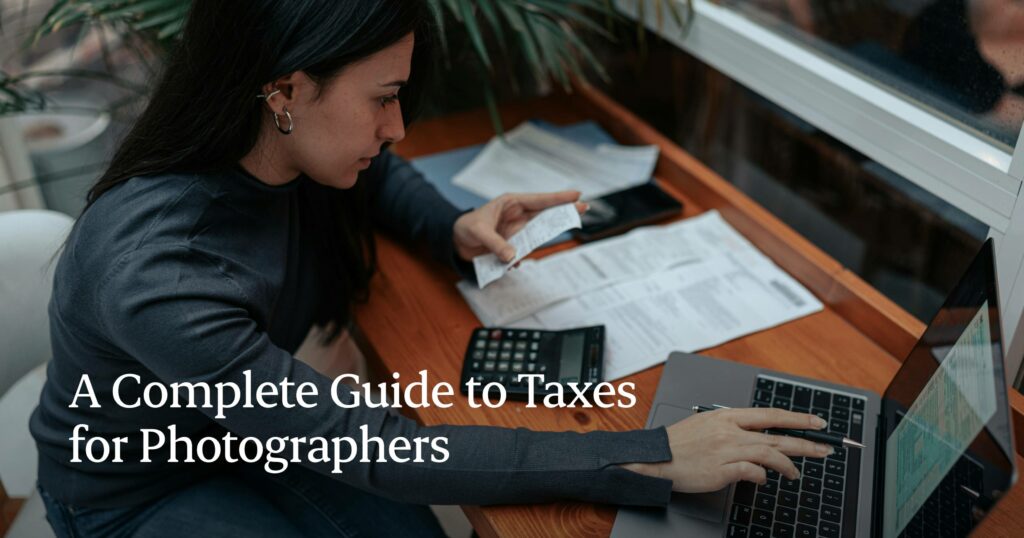A Complete Guide to Taxes for Photographers
The busy season for photographers is here!
And taxes for photographers can be overwhelming, especially when juggling shoots, edits, and business operations. No matter, if you are a freelance wedding photographer, a portrait studio owner, or a commercial photographer, tracking your taxes is crucial for keeping more of your hard-earned money and avoiding costly mistakes.
Unlike traditional employees who get a W-2, most photographers are self-employed, meaning you're responsible for tracking income, expenses, and deductions.

The good news? There are plenty of tax breaks designed to help small business owners like you. The key is knowing what you can write off, keeping organized records, and filing your taxes correctly.
In this guide, we'll walk you through everything you need to know about taxes as a photographer. Let’s dive right in

Understanding Your Tax Obligations
As a photographer, your tax obligations depend on how your business is structured and how you earn income. Unlike traditional employees who have taxes automatically withheld from their paychecks, most photographers are considered self-employed, meaning you’re responsible for tracking and paying your taxes.
The IRS treats businesses and hobbies differently for tax purposes. Businesses are intended to make a profit and can claim deductions for expenses, whereas hobbies are for personal enjoyment and do not operate with the primary intention of making a profit.
If an activity is classified as a hobby, the taxpayer must report any income received from it on their tax return.
However, expenses related to a hobby cannot be deducted to offset other income unless they are necessary personal expenses.
For tax years 2018 through 2025, miscellaneous itemized deductions, including hobby expenses, are not deductible.
If a business claims a net loss for too many years or fails to meet other requirements, the IRS may classify it as a hobby, which would prevent the taxpayer from claiming a loss related to the business or even claiming any expenses for the hobby
If you expect to owe more than $1,000 in taxes for the year, the IRS requires you to make quarterly estimated tax payments (April, June, September, and January).
What Forms Do You Need to File?
- Form 1040 + Schedule C: Used by sole proprietors and freelancers to report business income and expenses.
- Form 1099-NEC: If you paid any second shooters, assistants, or contractors more than $600, you’re required to send them a 1099-NEC and file it with the IRS.
- Form W-9: If a client hires you and requires tax documentation, they may request that you fill out a W-9 to provide your Taxpayer Identification Number (TIN).
Taxes for Photographers: Federal vs State
- All self-employed photographers must pay federal income tax and self-employment tax (Social Security & Medicare, currently 15.3%).
- Depending on where you live, you may also owe state income tax and sales tax (if you sell prints, albums, or photography packages that include tangible goods).
- Some states require photographers to collect and remit sales tax on digital products (e.g., online galleries, presets). Check your state’s tax laws to stay compliant.
Tax Deadlines
This isn’t the complete list but it's a starting point for photographers:
- If you operate as an S corporation or need to file a partnership return, your tax filing deadline is March 15th. Missing this deadline can result in significant penalties, so it's important to plan ahead.
- For sole proprietors, LLCs, or partners in a partnership, your tax payment is still due by April 15th, even if you file for an extension.
- If you do file an extension, you’ll have until October 15th to submit your return electronically but remember, the extension only gives you more time to file, not more time to pay.
What are the Acceptable Tax Deductions for Photographers?
One of the biggest perks of being a photographer is that many of your business expenses can be written off, reducing your taxable income and lowering your tax total deductions are greater than the Standardized Deductions. The “Standardized Deduction” is a set amount that you can deduct from your taxable income. The key is knowing what qualifies as a deduction, grouping them in categories, and recording them throughout the year. Here are the top tax deductions every photographer should take advantage of:
Here are the Standardized Deductions based on your filing:
Filing Status: Single
The single filer Standardized Deduction for 2025 is $15,000. So if you don’t have $15,000 of deductions you can itemize, then you take the Standardized Deduction. $15,000 is a lot of camera gear, conferences, airplane travel, etc.
If you’re 65 or older or blind, then you can claim an extra standard deduction of $2,000 so it becomes $17,000.
Filing Status: Married Filing Jointly
The standard deduction for ‘married individuals filing jointly’ is $30,000.
If you are married filing jointly and one person is 65 or older, you can add an extra $1,600 to your standard deduction so it becomes $31,600.
If both are 65 or older and blind, the additional standard deduction is $3,200, so it becomes $33,200.
Filing Status: Head of Household
Head of household means a taxpayer is unmarried or considered unmarried at the end of the year, has paid more than 1/2 the cost of keeping up a home (defined as where they live) for the tax year, and has a qualifying person - such as a child - who lived with them for more than half of the tax year unless the qualifying person is a dependent parent. This basically implies a single parent.
The standard deduction for Head of Household is $21,900.
List of Tax Deductions
Now let's discuss the tax write-offs you get as a photographer:

Photography Equipment & Gear
Your cameras, lenses, and other essential gear are some of the most significant expenses you’ll have as a photographer and they’re all tax-deductible! This includes:
- Cameras, lenses, tripods, and gimbals
- Memory cards, hard drives, and storage solutions
- Batteries, chargers, and cleaning kits
- Lighting equipment and modifiers
- Drones (if used for business)
Software & Subscriptions
If you use editing software or online tools for your business, they count as a deductible expense. Some common ones include:
- Adobe Creative Cloud (Photoshop, Lightroom)
- Capture One, Luminar, or other editing programs
- AI-assisted tools like Aftershoot for culling, editing, and retouching
- Online Cloud storage (Dropbox, Google Drive, iCloud)
- Business management tools (CRM software, invoicing apps)
Home Office Deduction
If you work from home, you may be eligible for a home office deduction. This applies if you have a dedicated space used exclusively for your business. You can deduct:
- Rent or mortgage
- Utility bills (electricity, internet)
- Office furniture and decor
- Repairs and maintenance for your workspace
Note: To claim the home office deduction, file IRS Form 8829 with your tax return. This form will help you calculate your deduction based on actual expenses incurred. If your business shows a loss, unused deductions can be carried forward to future years.
Travel and Transportation
Photographers often travel for shoots, weddings, and events. Keep track of all work-related travel expenses, including:
- Mileage (if using your personal vehicle for business)
- Gas, parking, and tolls
- Airfare, hotels, and rental cars for destination shoots
- Meals and per diem for out-of-town work
Marketing and Advertising
Promoting your photography business is essential, and all marketing expenses are tax-deductible. This includes:
- Website hosting and domain fees
- Social media ads (Facebook, Instagram, Google Ads)
- Business cards, flyers, and promotional materials
- Paid directory listings (The Knot, WeddingWire, etc.)
- Online galleries
Photography Education
Improving your skills and staying up-to-date in the industry is an investment in your business. You can deduct:
- Photography workshops and online courses
- Conferences and networking events
- Photography books and training materials
- Professional memberships (PPA, WPPI, local photography groups)
Insurance and Legal Fees
Running a photography business comes with risks, so many photographers invest in legal and insurance protections. Deductible expenses include:
- Business liability insurance
- Equipment Insurance
- Legal consultations and contract templates
Client Related Expenses
Certain costs associated with serving your clients can also be deducted. These include:
- Props and backdrops for shoots
- Client gifts (up to $25 per client per year)
- Studio rental fees
- Printing costs for albums and physical products
6 Tips to Organize Your Financial Records for Taxes
Now that you know all your tax write-offs, it is important to keep your financial records organized. Good recordkeeping isn’t just a tax-season task, it’s an essential part of running a successful photography business year-round. Whether you're a one-person show or managing a small team, staying organized will save you time, reduce stress, and help you avoid costly mistakes when it’s time to file.
#1. Use Accounting Software
Ditch the spreadsheets and upgrade to user-friendly accounting tools designed for freelancers and small businesses. These platforms help you track income, log expenses, send invoices, and even estimate taxes. Popular options include:
- QuickBooks Self-Employed
- FreshBooks
- Wave (free option for new business owners)
- HoneyBook or Studio Ninja (if you want to keep your business and finances together in one tool)
#2. Separate your Business and Personal Finances
One of the most important steps you can take as a photographer is opening a separate bank account and credit card for your business. This keeps personal and professional expenses from mixing, making it easier to track deductions and show clean records if you're ever audited.
#3. Track Every Expense (No Matter How Small)
That $10 lens cloth? It adds up. Get into the habit of recording every business-related purchase right away.
Use apps like:
- Expensify or Shoeboxed to scan and categorize receipts
- MileIQ to automatically track business mileage
- Google Sheets + Receipt folders (if you prefer a DIY approach)
#4. Organize Income Sources
Photographers often have multiple revenue streams — weddings, portraits, mini sessions, digital downloads, workshops, etc. Set up systems to:
- Label and sort payments by service type
- Match invoices to payments received
- Store client contracts and payment records in one place (Google Drive, CRM, or project management tool)
Read also: 8 Ways to Diversify Your Wedding Photography Income
#5. Set a Monthly “Money Day”
Schedule one day each month to review your finances. This could include:
- Reconciling bank statements
- Reviewing income and expenses
- Backing up receipts and files
- Preparing for quarterly estimated tax payments
#6. Save for Photography Taxes
Freelance and small business photographers usually need to pay quarterly estimated taxes. To stay prepared, set aside 20–30% of each payment you receive in a separate high-yield savings account. This helps avoid surprises when tax time rolls around. A little consistency throughout the year can make a big difference when it's time to file.
Take Control of the Tax Season and Your Photography Business
Tax season doesn’t have to be overwhelming or stressful. With the right systems in place, it can actually be a powerful opportunity to take control of your finances, reduce your tax burden, and set your photography business up for long-term success.
Whether you handle taxes yourself or work with a professional, the key is to stay informed, consistent, and proactive. Because when your finances are in order, you’re free to focus on what you love most creating beautiful work behind the lens.
Here’s to a smooth, stress-free tax season and an even more profitable year ahead!
